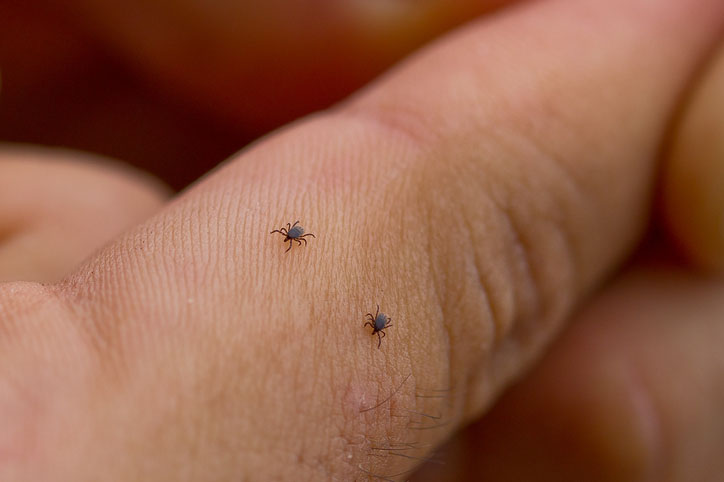Filth-breeding Flies
- Flies
- Overview of Flies
- Dipterans with Biting Mouthparts
- Black Flies
- Sand Flies
- Biting Midges
- Mosquitoes
- Horse Flies and Deer Flies
- Stable Flies
- Horn Flies
- Buffalo Flies
- Tsetse Flies
- Sheep Keds
- Spider Flies/New Forest Flies
- Hippoboscid or Louse Flies
- Dipterans with Nonbiting Mouthparts
- Face Flies
- Head Flies
- Filth-breeding Flies
- Eye Gnats
- Dipterans that Produce Myiasis
- Facultative Myiasis-producing Flies
- Obligatory Myiasis-producing Flies
- Pseudomyiasis
The following adult dipterans are often referred to as filth-breeding flies: Musca domestica (the house fly); Calliphora, Phaenicia, Lucilia, and Phormia spp (the blow flies or bottle flies); Sarcophaga spp (the flesh flies); Fannia spp (the little house flies); Muscina spp (the false stable flies); and Hermetia illucens (the black soldier flies). Large populations of these adult flies are often found around facilities associated with animal feces. Larval stages may be associated with skin wounds contaminated with bacteria or with a matted hair coat contaminated with feces (see Facultative Myiasis-producing Flies). The life cycle of M domestica will be used as a representative example of the life cycles of the assorted filth-breeding flies.
The house fly is commonly found around livestock and poultry operations, where it readily breeds in accumulating manure sources. It is a medium-sized (as large as 9 mm), grayish fly with four dark thoracic stripes and sponging, nonbiting mouthparts designed for sucking semiliquid food (there are no mandibles or maxillae). The labium is expanded into two labellae that can transfer fluids and semifluids.
After oviposition, the creamy-white, banana-shaped egg (~1 mm long) hatches in 6–12 hr in optimal conditions. The eggs are not resistant to drying, and few appear to survive temperatures >40°C or <15°C. Larvae may develop in a few days to 3 wk, depending on the temperature and availability of food. When temperature for larval development is optimal (~36°C), the larvae develop to pupae in ~6 hr. Pupae persist 4–5 days in warm weather. After the adults emerge, the flies search for food and copulate after a few days. The life cycle is usually completed in ~3 wk, although it can be completed in as little as 10–14 days under favorable conditions. In temperate climates, it is thought that house flies overwinter as pupae.
Pathology:
Even though these flies do not feed on blood, annoyance caused by their movement on and off animals can lead to reduced performance. In addition, they have been implicated in the transmission of numerous pathogens (helminth, protozoan, bacterial, and viral) of people and other animals. Large populations of these adult flies often are found around poorly managed livestock or poultry facilities and become a public annoyance. These are synanthropic flies, ie, they are often associated with human dwellings. The flies are “vomit drop” feeders and fly from feces to food, spreading bacteria on their feet and within their disgorged stomach contents.
Diagnosis:
All adult filth-breeding flies have similar sponging, nonbiting mouthparts, designed for sucking semiliquid food. The identification of adult flies is probably best left to a specialist. House flies are medium-sized, grayish flies with four dark thoracic stripes. A preliminary identification of blow flies or bottle flies may be made on the basis of the metallic coloring of the adults. Flesh flies are medium-sized, grayish flies with a checkerboard abdominal pattern.
Treatment and Control:
A thorough sanitation program is necessary to control fly populations in and around livestock and poultry facilities. All manure accumulations should be removed at least twice a week or handled properly, if stored on the premises, to minimize fly breeding. If solid manure management practices are applied, efforts should be made to reduce manure moisture. If a liquid manure pit is used, manure should not be allowed to accumulate above the waterline, either floating or sticking to the sides, because this is an ideal site for fly reproduction. Insecticides should be considered as supplementary to sanitation and management measures aimed at preventing fly breeding. Residual sprays providing 2–4 wk control with one treatment may be applied to fly-resting surfaces. Space sprays, mists, or fogs with quick knockdown but no residual action can be used for immediate reduction of high numbers of adult flies. Other measures for control of adult flies include use of insecticide resin strips or various fly baits. These measures also can be applied directly to fly-breeding sources; however, this should be considered only for fly-breeding spots that cannot be eliminated by normal sanitation practices.
- Flies
- Overview of Flies
- Dipterans with Biting Mouthparts
- Black Flies
- Sand Flies
- Biting Midges
- Mosquitoes
- Horse Flies and Deer Flies
- Stable Flies
- Horn Flies
- Buffalo Flies
- Tsetse Flies
- Sheep Keds
- Spider Flies/New Forest Flies
- Hippoboscid or Louse Flies
- Dipterans with Nonbiting Mouthparts
- Face Flies
- Head Flies
- Filth-breeding Flies
- Eye Gnats
- Dipterans that Produce Myiasis
- Facultative Myiasis-producing Flies
- Obligatory Myiasis-producing Flies
- Pseudomyiasis





